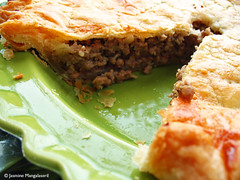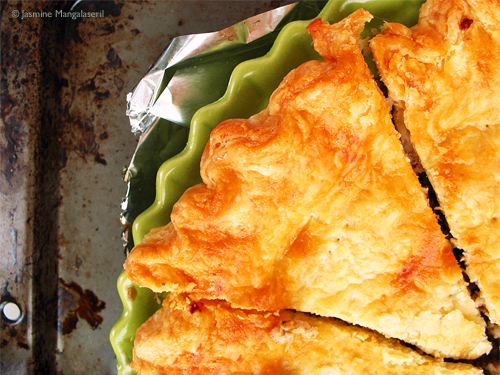Happy π Day!
Given this year
is a special pi year (if you don't know, look at the number below and you'll
see it), it only made sense to join in this roundly delicious celebration.
How better to
celebrate 3.141592653 (et cetera) in the land of math and physics geniuses than
with a very Canadian pie? I thought of butter tarts (which are just little pies), flapper pie and bumbleberry pie but
I wanted something savoury. To my mind, the quintessential Canadian savoury pie
is “tourtière,” the Quebecois meat pie, traditionally eaten over the Christmas-New Year season.
Tourtière falls
within the millennia-old tradition of pie-making, with distant ancestors traced
to ancient Egypt and Sumeria. The Romans helped spread pie-making throughout their empire, and soldiers returned
from the Crusades with Middle Eastern pies.
European explorers, missionaries and colonists continued to spread
pie-making traditions throughout the world.
Regional
variations mean it’s difficult to declare an “authentic tourtière.” General agreement among Quebeckers seems to end with the point that tourtières are double-crusted savoury pies. The pies can be:
- Made in shallow pie tins or deep cast iron pots
- Fish pies or meat pies, with or without veg or grains
- Filled with one or several meats
- Made with ground or diced meat
So why do I think tourtière is quintessentially Canadian?
- According to Chef Richard Bergeron, 17th Century France provided the pie's five essential seasonings--allspice, cinnamon, clove, nutmeg, and pepper.
- Quebec food journalist Julian Armstrong found British influences in ingredients rolled oats (Scottish) and potatoes (Irish), and form (the deep dish sea-pies from the 18th Century British Navy).
- It takes advantage of regional ingredients such as pork, game, veal and/or beef; coastal variations can use fish.
- While purists may decry modern interpretations, some newer recipes use ingredients that indicate the diversity of Canadian tastes such as meatless fillings and chicken or include garlic or soy sauce.
This straightforward recipe is very much like the first tourtière I tried -- a rich ground pork pie and lightly spiced. Served with a dollop of HP sauce, buttery peas and creamy mash, it makes a delicious winter's meal. And that's not an irrational declaration.

Tourtière
Adapted from a recipe by Julian Armstrong
Yield 1 23cm (9") pie
Ingredients
600g / 1.33lb minced regular pork (see notes)
190ml /0.75c cold water
125ml / 0.5c finely chopped onion (approximately 1/2 a medium onion)
62ml / 0.25c finely chopped celery (approximately 1/2 a rib)
1 bay leaf
0.5tsp / 2.5ml pepper
0.5tsp / 2.5ml dried summer savory (see notes)
0.25tsp / 1.25ml dried rosemary
0.25tsp / 1.25ml nutmeg
0.25tsp / 1.25ml cinnamon
0.25tsp / 1.25ml allspice
Salt, to taste
25g / 60ml / 0.25c rolled oats
Pastry for one 23cm (9") double-crust pie (see notes)
1 beaten egg
Method
In a heavy
bottomed pan, combine water with pork and bring to a boil.
Add onion,
celery, herbs and spices (except for salt). Cover
and cook over a medium-low flame for about 30 minutes, stirring often. Add more water, if the mixture begins to dry.
Taste the
mixture, and add salt, to taste. Stir in the oats, cover and continue to cook
(still stirring often). Remove bay leaf and let the mixture cool.
Preheat oven to
210C/425F
Line the pie tin
with pastry. Evenly spread the filling
in the lined tin, brushing the edge with egg. Cover the pie with the top crust,
seal the edge. Trim and crimp. Cut steam vents, in the usual way, and brush
the surface with egg wash.
Bake for 15
minutes.
Reduce heat to
180C/375F and continue to bake until the crust is golden (approximately 25-35
minutes).
Cool slightly
(about 10-15 minutes) before slicing.
- Pickled vegetables (such as jardinière, pickled beets, vinegary coleslaw)
- Sauce (such as cranberry sauce, HP, chowchow)
Notes:
- Regular pork adds a richness to the pie that lean pork lacks. If you prefer lean pork, by all means use it.
- If you can't find summer savory, substitute with winter savory or thyme.
- I prefer meat pies with a savoury flakey crust, but a shortcrust would work as well.
- This recipe should convert easily to handpies or individual pot pies.
cheers!
jasmine
I'm a quill for hire!


No comments:
Post a Comment